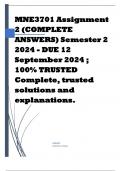MNE3701 Assignment
2 (COMPLETE
ANSWERS) Semester 2
2024 - DUE 12
September 2024 ;
100% TRUSTED
Complete, trusted
solutions and
explanations.
ADMIN
[COMPANY NAME]
,MNE3701 Assignment 2 (COMPLETE ANSWERS)
Semester 2 2024 - DUE 12 September 2024 ; 100%
TRUSTED Complete, trusted solutions and explanations.
Having acquired sufficient knowledge and skills on financial
management for small business, you must demonstrate practical
competencies in constructing financial statements and in
conducting feasible financial forecasting. As a new entrepreneur
understanding financial management and accounting, forms an
integral part of running your small business. You should also be
able to forecast the financial outcomes that could result from
your decision. The projections of business’s profits, its assets
and financial requirements, and its cash flows are essential in
determining whether your business is economically viable or
not. In light of the above citation you are expected to respond to
the following assessment criteria: QUESTION 1 • Demonstrate
how you would go about constructing financial statements of
your small business with reference to practical examples. (30)
Constructing Financial Statements for a Small Business
Financial statements are essential tools for understanding the
financial health of a business and guiding decision-making.
There are three key financial statements a small business needs
to prepare: the Income Statement, the Balance Sheet, and the
Cash Flow Statement. Each provides a different perspective on
the financial position of the business. Below is a step-by-step
guide to constructing these financial statements with practical
examples.
, 1. Income Statement (Profit and Loss Statement)
The income statement summarizes the revenues and expenses
over a specific period, showing whether the business made a
profit or incurred a loss.
Steps to Prepare an Income Statement:
1. Determine Revenue:
o List all sources of income (sales revenue).
o Example: Assume your business sells homemade
clothing. If in a month you sold 200 items at an
average price of R200 each, your total revenue would
be:
Total Revenue=200 items×R200=R40,000\text{Total
Revenue} = 200 \text{ items} \times R200 =
R40,000Total Revenue=200 items×R200=R40,000
2. Calculate Cost of Goods Sold (COGS):
o COGS represents the direct costs involved in
producing goods or services.
o Example: If the cost to produce each item is R100,
your COGS would be:
COGS=200 items×R100=R20,000\text{COGS} = 200
\text{ items} \times R100 =
R20,000COGS=200 items×R100=R20,000
3. Determine Gross Profit:
o Gross profit is the revenue minus the COGS.
o Example:
Gross Profit=Revenue−COGS=R40,000−R20,000=R2
0,000\text{Gross Profit} = \text{Revenue} -
\text{COGS} = R40,000 - R20,000 =





